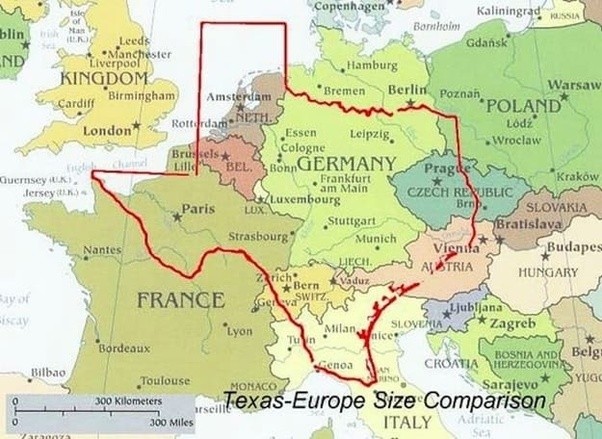Texas is undeniably vast. But exactly how big is the Lone Star State compared to the rest of the United States? With an area of 268,597 square miles (or 171,902,080 acres), Texas is the second-largest state in the US. It dwarfs California, the third largest, by about 1.65 times. However, even Texas pales in comparison to Alaska, the undisputed champion, which is nearly 2.5 times larger at 663,300 square miles. Despite its size, Texas boasts a booming population of 30.5 million residents (as of 2023) and an impressive economy, ranking 8th globally with a GDP of $2.6 trillion, surpassing entire countries like Canada, Russia, and Italy.
Why Texas’s Size is So Significant
Unlike many other states formed by dividing existing territories, Texas entered the Union as a large, independent republic. This unique history preserved its vast expanse. Interestingly, Texas was once even larger, encompassing parts of present-day New Mexico, Colorado, Oklahoma, and Kansas. Delving into Texas’s rich history reveals the fascinating story behind its current boundaries.
Texas vs. the US: A Size Comparison
While Texas is undeniably large, it represents about 7% of the total land area of the US (3.797 million square miles). Put another way, the United States is 14 times larger than Texas. Economically, Texas pulls its weight, contributing approximately 9% to the US economy with its $2.6 trillion GDP. Its population of 30.5 million accounts for roughly 9.22% of the total US population.
Mind-Blowing Facts About Texas’s Size
Here are ten lesser-known facts that highlight the sheer scale of Texas:
- The entire world population (7.8 billion) could theoretically fit within Texas if it had the same population density as New York City (27,000 people per square mile).
- If Texas were a country, it would be the 40th largest globally, surpassing every European nation in size.
- King Ranch, the largest ranch in the US, sprawls across 1,289 square miles within Texas, exceeding the entire state of Rhode Island.
- The fastest road in the US, with an 85 mph speed limit, stretches for 40 miles between Austin and San Antonio, Texas.
- El Paso, Texas, is geographically closer to Denver, Colorado (637 miles), than to Houston, Texas (747 miles).
- El Paso is also closer to the Pacific Ocean (San Diego, California) than to Texarkana, Texas.
- The “Texas Triangle” – encompassing Dallas, Fort Worth, Houston, Austin, and San Antonio – houses over 21 million of Texas’s 30.5 million residents.
- The Dallas/Fort Worth International Airport, covering 27 square miles, is larger than the island of Manhattan.
- U.S. Route 83, the longest highway in Texas, spans 783.5 miles from the Oklahoma border to Brownsville on the Mexican border.
- Texas boasts the largest domed state capitol building in the US, with a staggering 18 acres of floor space.
Fitting States Within Texas
Fifteen of the smallest US states could fit comfortably within Texas: Kentucky, Virginia, Indiana, Maine, South Carolina, West Virginia, Maryland, Vermont, New Hampshire, Massachusetts, New Jersey, Hawaii, Connecticut, Delaware, and Rhode Island. Furthermore, every state except for Alaska can fit within Texas individually. California, the third-largest state, could fit into Texas approximately 1.6 times, while Rhode Island, the smallest, could fit a remarkable 221 times.
Texas vs. International Comparisons
Texas’s size even rivals that of entire countries. It’s significantly larger than England (more than five times) and slightly bigger than France (about 8%). Countries like Myanmar (Burma) and Zambia are also comparable in size to Texas. The United Kingdom is considerably smaller than Texas (2.8 times), although it has a larger population and GDP. Germany is almost half the size of Texas, while Japan is significantly smaller (Texas is 84% larger).
Driving Across the Lone Star State
Driving across Texas is a testament to its size. An east-to-west trip spanning 773 miles takes approximately 11 hours of non-stop driving. A north-to-south journey covering 805 miles requires around 13 hours.
Conclusion: Texas-Sized Proportions
Texas’s sheer size has shaped its identity, economy, and culture. From its vast ranches and expansive highways to its booming cities and diverse population, everything about Texas is on a grand scale. Its size is not just a statistic; it’s a defining characteristic that sets it apart within the United States and on the global stage.

